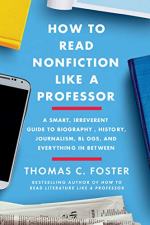
|
| Name: _________________________ | Period: ___________________ |
This quiz consists of 5 multiple choice and 5 short answer questions through Section 2: Chapter 5, "It May Just Be Me, But..." through Chapter 8, "Bringing the News".
Multiple Choice Questions
1. In Chapter 5, "It May Just Be Me, But..." what kind of person does Foster say is likely to be biased?
(a) Everyone.
(b) Uneducated people.
(c) Republicans.
(d) Older people.
2. The section of this book called "What's Going on Around Here?" is what part of the book?
(a) The introduction.
(b) A preface.
(c) An appendix.
(d) A foreward.
3. According to "The Building Blocks of Arguments," what are the "grounds" of a argument?
(a) Factual data and evidence.
(b) Explanations of the relationship between facts and claims.
(c) The backing of a rebuttal or qualification.
(d) The conclusions that an argument is based on.
4. In Chapter 4, "The Parts You Don't Read," what part of a text does Foster say is "under-read"? (39).
(a) Introductions.
(b) The index.
(c) The table of contents.
(d) Titles.
5. In Chapter 6, "Source Code," where does Foster suggest writers should gather information about historical figures?
(a) Primary sources.
(b) Newspaper archives.
(c) History books.
(d) Biographies.
Short Answer Questions
1. In Chapter 6, "Source Code,"what does Foster say about researching primary sources on microfiche?
2. In Chapter 2, "The Ecology of the Nonfiction Biosphere," what implicit assertion about online writing does Foster make?
3. In Chapter 2, "The Ecology of the Nonfiction Biosphere," what does Foster say is the difference between "hard news" and "soft news"?
4. In Chapter 2, "The Ecology of the Nonfiction Biosphere," what problem does Foster say can arise if readers do not understand the forms of writing?
5. In Chapter 7, "All in How You Look at Things," what does Foster say is the purpose of the academic five-paragraph essay?
|
This section contains 454 words (approx. 2 pages at 300 words per page) |

|




